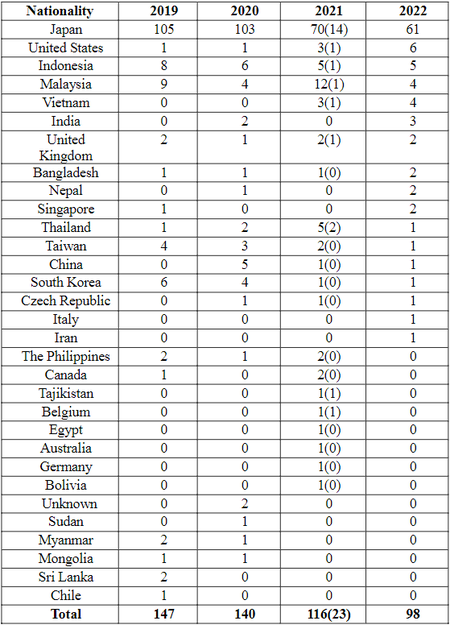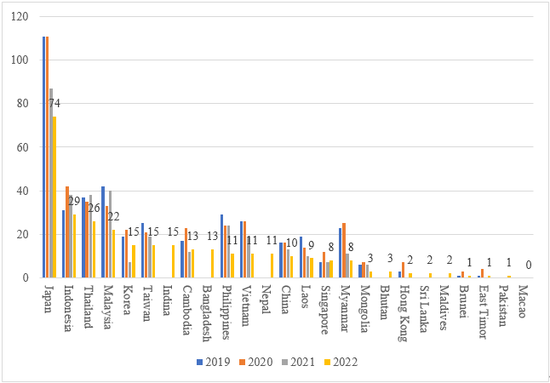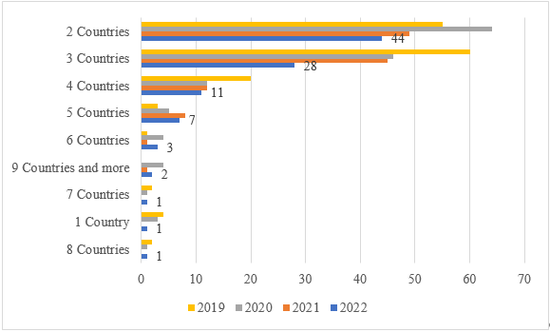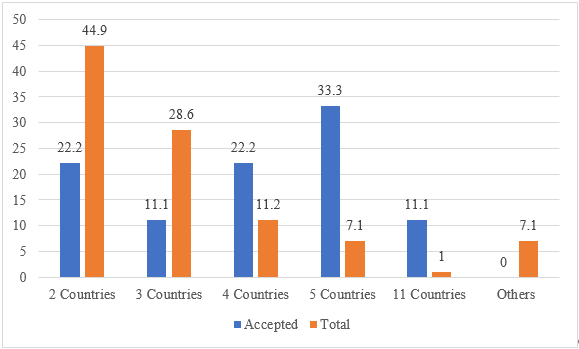Selection Committee Chair Prof. Shigeto Sonoda
Outline of Fiscal 2022 International Grant Program “Cultivating Empathy Through Learning from Our Neighbors: Practitioners’ Exchange on Common Issues in Asia”
This is the fourth time for me to provide commentary on the selection results, which I started to do in fiscal 2019. Each year, we made minor changes in calling for applications for the International Grant Program.
The category of prioritized area, which was introduced in fiscal 2019, was abolished in fiscal 2020, making the program completely open to applications on various issues. In fiscal 2021, we introduced the One-Year Grant to call for innovative proposals focusing on online activities, which can be carried out without cross-border movement of people. In fiscal 2022, we called for applications for the One-Year Grant in the conventional way, without treating it as a separate category, and newly added South Asian countries (Bangladesh, Bhutan, India, Maldives, Nepal, Pakistan, and Sri Lanka) to the targeted countries.
However, the key points of the International Grant Program remain unchanged. Its purpose is to support proposed projects that are aimed at solving common issues in Asia through learning from each other and which include the following Four Elements.
(1) Transnationality: The project must cover at least two countries in East Asia, Southeast Asia, and South Asia, and the project members must also be from at least two countries. In addition, any achievement made through the project or an effect produced by it must cover multiple countries.
(2) Cross Sectoral Approach: A sufficient number of experts from multiple sectors (such as researchers, NPO staff, businesspersons, and government officials), who are to solve the problem, must be participating in the project under an organic relationship.
(3) Mutual Learning: Project participants must have built a relationship of mutual learning to carry out the project.
(4) Foresight: The project must have a clear vision of its outcomes and must consider the impact it will have after the end of the grant and the possibility of its future development. It must also cover problems that could occur in the future and reflect a new perspective beyond conventional frameworks.
Overview of the Situation and Details of Application
The open call for proposals started on April 1, 2022, and applications were accepted until June 4. Forty-five applicants, 25 of whom used Zoom, consulted with program officers (POs) online before submission. Of the 242 projects that registered in advance, 98 (40.5%) of them applied for a grant.
Seventeen of the 98 applications (17.3%) were for the One-Year Grant. In fiscal 2021, there were 23 applications for the One-Year Grant, accounting for 19.8% of the total number of applications, so applications decreased slightly both in absolute number and percentage of the total.
The distribution of nationalities of applicants is shown in Table 1. The number of Japanese applicants drastically increased in 2019 when we added the condition that the representative must be a resident of Japan. In fiscal 2022, however, slightly above 62% of applicants were Japanese, having declined from the previous ratios of around 70%. This time, the number of applicants of US nationality increased, and so did the number of applicants from India, Bangladesh, and Nepal because the South Asian countries were added to the targeted countries. On the other hand, there was a decline in the overall number of applicants of East Asian nationalities.
Table 1: Distribution of the nationalities of project representatives for fiscal 2019-2022

Fig. 1 shows the distribution of countries/regions stated in the proposed projects and Fig. 2 shows the number of the countries/regions covered by the project. Because the total number of applications decreased, the numbers declined in almost all the categories. It is good news, however, that 15, 13, and 11 applications were from India, Bangladesh, and Nepal, respectively, as these numbers are comparable to those for the East Asian and Southeast Asian countries/regions.
Fig. 1: Targeted countries/regions that were stated in application forms for fiscal 2019- 2022

Fig. 2: Number of targeted countries/regions that were stated in application forms in 2019-2022

Selection process and results
The selection committee was made up of four members including the committee chair, half of whom are new members who joined the committee this fiscal year.
First, three POs closely reviewed the 98 applications. They eliminated incomplete application forms and applications that were judged not to include the Four Elements described above, before they asked each committee member to evaluate the remaining applications. (For example, as Fig. 2 shows, one application in fiscal 2022 covered only one country, which was eliminated from subjects of the evaluation.)
The four committee members read the applications carefully, selected the applications that they could recommend, weighing the evaluations of some of the projects. If a member of the selection committee had any question about the content, schedule, budget plan, or other matters, or found room for improvement in the dissemination of the achievements and their outcomes, he or she informed the POs to that effect. The POs communicated the questions/concerns to the applicants, received their replies and communicated the replies to the committee members. Then, the results of the reviews by the four committee members were merged before a selection committee meeting was held.
At the beginning of the meeting, the committee eliminated applications that had not been recommended by anyone. All members commented on applications that at least one of the members had recommended, and examined the replies from the applicants before deciding whether to accept each application or not. They made the final decision on the winning projects by checking for overlap in the countries/regions covered and project themes, adjusting the amounts of grants so that the total amount would not exceed 70,000,000 yen.
The nine projects selected for this fiscal year have the following characteristics.
First, all nine of the winning projects are for Two-Year Grant, and none were selected from applications for One-Year Grant. In my commentary on the selection results for fiscal 2021, I pointed out that “There were many applications filled with enthusiasm among those for the Two-Year Grant. Many conveyed a strong message, such as ‘A project like this is all the more necessary for the COVID-19 pandemic.’” A similar trend was seen again this fiscal year.
Second, the number of countries/regions covered by the winning projects increased. As Fig. 3 shows, 44.9% of all proposed projects covered two countries, while only 22.2% of the selected winning projects covered two countries. Among successful applications, those covering many countries were the majority. We can tell by information given in the application forms that many of the applicants already have good relationships for specific collaborations in those regions and have maintained these relationships through online communication even during the COVID-19 pandemic.
Third, many successful applicants had received grants from the Toyota Foundation before, which was also pointed out in preceding years. Specifically, 19.4% of all applications submitted this year were from applicants who had received grants from the Toyota Foundation before, and this number will go up to 33.3% when confined to the successful applications. Furthermore, many successful applicants received suggestions and advice from POs in their prior consultation. We may safely say that projects planned meticulously by those applicants who can write applications skillfully were more likely to be selected.
Fig. 3: Numbers of targeted countries/regions that were stated in the applications: Ratios to the number of selected projects and the total number of applications (%)

The common issues in Asia to be addressed by the selected projects include issues in the same areas as the projects selected last fiscal year, such as climate change, cancer protection, and international migration. They also include issues in areas where proposals have rarely gone, such as the promotion of the integrity of research and the development of remote education programs online. Such new proposals are enormously welcome.
Funds granted per project is smaller than in previous years because of the large number of winners receiving a Two-Year Grant. I hope that successful applicants will effectively use their grant.
Introducing Adopted Projects
The following introduces one of this fiscal year's winning projects, which was highly evaluated by the selection committee members.
| Masako Tanaka," Mother tongue and national language education for transnational migrant children: Roles of the host country for Non-Formal Education Classes run by migrant communities in Japan" |
| Countries: Japan, Nepal, Bangladesh, Myanmar, and the United States |
| Term: 2 years |
| Amount: 10,000,000 yen |
This project helps Nepalis, Bangladeshis, and Burmese living in Japan. It focuses on classrooms teaching remedial classes where their children learn their first languages, and increases the visibility of the classrooms in local communities. Specifically, the goal of the project is to create an environment that facilitates the involvement of local governments, NPOs and volunteers through interactions with teachers from the classrooms and local children and through the provision of open classes. The project also includes research exclusively for Nepalis, as there are many Nepali children residing in Japan. In this research, these children's reintegration into Nepali society will be investigated and some policy recommendations for the Nepalese government will be explored. The project also intends to summarize the achievements of the activities in the form of a documentary video and release it on YouTube with Japanese and English subtitles to attract a broader audience.
This project was highly evaluated for its novel idea of viewing immigration not as a one-way flow of people but as a two-way flow of people who come and go between two countries, and for its targeting both the sending countries and the recipient country. This proposal could also be a good candidate project for the Migrants and Japanese Society Special Subject program. We look forward to the future development of this project.
Conclusion
Since 2019, when I became the selection committee chair, the total number of applications has been gradually decreasing. Applications targeting South Asia began to be accepted this fiscal year, but this change has yet to stop the gradual decline in the total number of applications. To increase the number of applications, we need to take some measures to encourage those who pre-registered to submit their applications as well as our ongoing efforts to advertise our program. In fact, the number of those who pre-registered is slightly more than 2.4 times the number of applicants.
I strongly encourage those who have some ideas to contact the POs of Toyota Foundation, because it is a good time to start a new project when we are recovering from the COVID-19 pandemic. As I have already pointed out, applications written by applicants who have been able to receive suggestions and advice from the POs are more likely to be accepted.
You can also get some suggestions and inspiration through the reading of published reports by the Toyota Foundation. For example, you can obtain some concrete advice for the preparation of the application from the report “Ethics and Logics of International Collaborative Projects”![]() (June 2022), pp. 21-25. I strongly recommend that those who are seriously considering lodging an application for the grant read it.
(June 2022), pp. 21-25. I strongly recommend that those who are seriously considering lodging an application for the grant read it.
